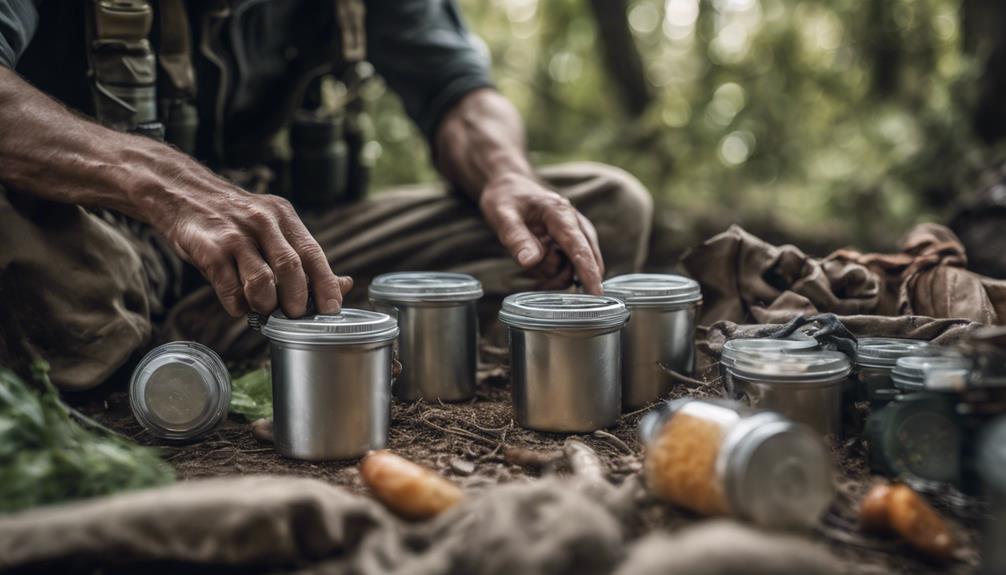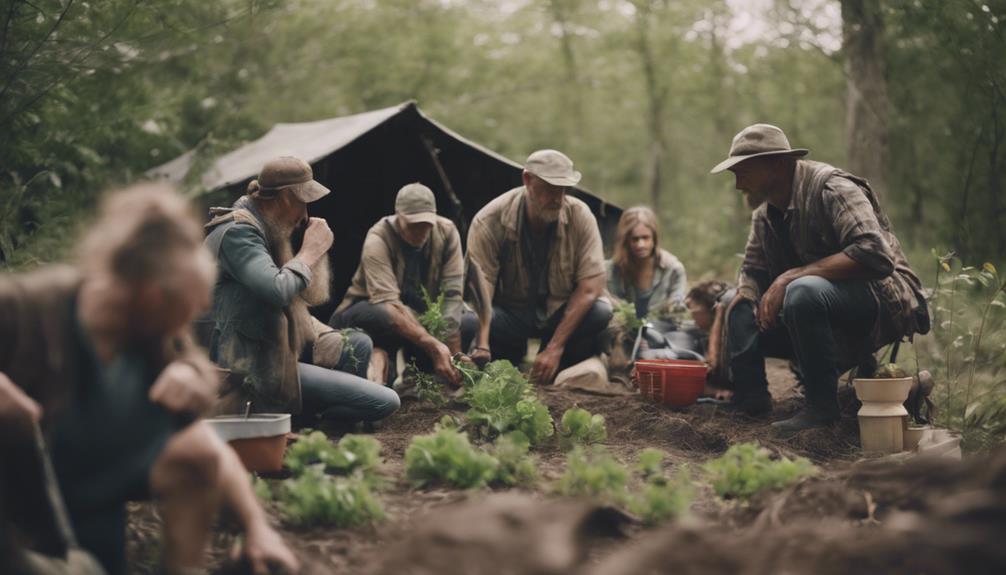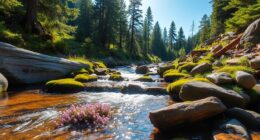Coexisting safely with wildlife is essential for a healthy ecosystem and community. By understanding local species and their behaviors, you can reduce conflicts and foster mutual respect. Implementing strategies like habitat restoration and establishing wildlife corridors helps maintain biodiversity. Engaging your community in conservation initiatives not only protects wildlife but also empowers everyone involved. Together, you can promote economic incentives to offset any risks associated with wildlife interactions. Embracing this awareness allows for more sustainable living, and the benefits go beyond nature itself. If you're curious about more ways to protect both wildlife and your community, there's much more to discover.
Key Takeaways
- Understanding local wildlife behaviors fosters respect and reduces human-wildlife conflicts, promoting safer coexistence.
- Implementing non-lethal management strategies, such as guard dogs and fencing, protects livestock while allowing wildlife to thrive.
- Community engagement in wildlife conservation initiatives enhances local knowledge and fosters long-term commitment to coexistence efforts.
- Education and awareness campaigns about local species contribute to responsible interactions, reducing potential conflicts with wildlife.
- Creating wildlife corridors and restoring habitats facilitates safe animal movement and maintains ecological balance, benefiting both wildlife and human communities.
Importance of Coexistence

Coexistence with wildlife is essential for maintaining a healthy ecosystem. When you foster this balance, you're not just protecting nature; you're also ensuring agricultural stability. Humane management strategies help prevent damage to your crops and livestock, safeguarding food security by maintaining nutrient cycles and pest control. A balanced ecosystem supports not just your local environment but also contributes to the creation of new sustainable economies like ecotourism. Furthermore, engaging with wildlife can enhance children's critical thinking skills, as they observe and learn about their behaviors and habitats through interactive experiences.
Moreover, wildlife tourism generates significant revenue, contributing over $120 billion to the global GDP, which far surpasses illegal wildlife trade profits. This sector provides around 9.1 million jobs worldwide, particularly benefiting communities in regions like Asia-Pacific and Africa. By engaging in wildlife tourism, you're supporting local livelihoods and encouraging responsible practices that combat wildlife trafficking.
Your interactions with wildlife can enhance your well-being, reducing stress and fostering happiness. Positive experiences with nature create a sense of purpose and promote pro-environmental behaviors. By embracing coexistence, you empower communities to take ownership of conservation efforts, leading to more effective practices. Ultimately, your commitment to coexistence nurtures both wildlife and the planet, creating a brighter future for all. Additionally, evidence supports that coexistence strategies lead to reduced conflicts and lower management costs, further underscoring the importance of harmony with wildlife.
Effective Conflict Reduction Methods

Reducing human-wildlife conflict requires a proactive approach that tackles the root causes while respecting both human needs and wildlife conservation. One effective method is habitat management and restoration. By restoring natural habitats, you can maintain ecological balance, reducing wildlife encroachment into human areas. Creating wildlife corridors, reducing fragmentation, and enhancing biodiversity are essential practices for sustainable land use. Over 1 billion people are affected globally by wildlife conflicts annually, highlighting the urgent need for these strategies.
Non-lethal management interventions also play an important role. You can employ range riders, guard dogs, and fladry to protect livestock from predators like wolves and grizzly bears. Adjusting livestock grazing locations to avoid predator habitats helps minimize conflict. Utilizing predator-deterring stimulants can further discourage unwanted wildlife encounters.
Additionally, economic and financial mitigation strategies can encourage communities to be more tolerant of wildlife. Providing economic incentives, alternative livelihoods, and compensation schemes can reduce the financial risks associated with wildlife interactions.
Community Engagement and Initiatives

Community engagement plays a significant role in wildlife conservation efforts, as it harnesses local knowledge and fosters collaboration between residents and conservationists. Your community often holds extensive insights about local ecosystems and species, enhancing scientific data and conservation strategies. By involving community members in surveillance efforts, you can effectively protect wildlife from threats like poaching and address specific conservation needs. Projects that engage the community typically achieve higher success rates and guarantee that conservation strategies are supported and sustained locally. When you actively participate in planning and decision-making processes, you help create initiatives that yield positive results in safeguarding endangered species. Building relationships based on trust and respect is imperative, and providing education on conservation benefits can foster long-term commitment.
Additionally, community involvement contributes to the creation of tailored solutions that address local issues, ensuring a more effective approach to conservation. Addressing challenges such as cultural differences and economic impacts is essential to guarantee everyone feels included. By promoting equity in the sharing of costs and benefits, your community can truly thrive. Through outreach programs, workshops, and sustainable employment opportunities, you can actively contribute to a resilient environment while enjoying the rich diversity of nature around you.
The Impact of Wildlife Decline

Wildlife decline poses a critical threat to ecosystems and human well-being alike. When you consider that land use change for food production drives 30% of biodiversity loss, it's evident that our choices impact nature. Overexploitation, like overfishing and overhunting, accounts for another 20%. In regions like Central and South America, wildlife populations have plummeted by 94% since 1970, largely due to habitat destruction.
The consequences extend beyond loss of species. Freshwater populations have fallen by 84%, and fish stocks are largely overexploited. In North America, wildlife populations have declined by 33%, affecting the balance of ecosystems. You might not realize it, but every species plays a role, and their decline can trigger a domino effect, disrupting food chains and natural processes. Additionally, 73% decline in global wildlife populations from 1970 to 2020 underscores the urgency of addressing these issues.
Climate change, now a significant driver of biodiversity loss, threatens to exacerbate these issues. As ecosystems unravel, you'll face more severe impacts on health and livelihoods, from diminished resources to increased natural disasters. The decline is a warning sign; we're approaching irreversible tipping points that could reshape our world. It's crucial to recognize this challenge and act before it's too late.
Educational Outreach and Programs

Frequently engaging young minds through educational outreach programs is essential for fostering a lifelong connection with the natural world. By immersing children in nature-based learning, you can help them develop a sense of responsibility and respect for their environment. Outdoor classrooms, nature walks, and hands-on projects like schoolyard habitats create memorable experiences that enhance their understanding of wildlife and ecosystems. Additionally, learning about sustainable management of working forests illustrates the importance of conservation efforts and encourages youth to participate in protecting their local environments. Moreover, incorporating digital creativity into these programs can inspire innovative ways for children to engage with nature and document their experiences.
Consider these key aspects of educational outreach:
- Nature walks help kids observe wildlife and plants in their natural settings.
- Nature-inspired curricula integrate environmental education across various subjects.
- Community involvement fosters a sense of ownership and responsibility toward local habitats.
- Eco-Schools USA promotes sustainable practices in schools, encouraging green initiatives.
- Leadership programs prepare youth for careers in environmental stewardship.
Frequently Asked Questions
What Are the Signs of Wildlife Presence Near My Home?
To spot wildlife near your home, listen for noises like scurrying or scratching, especially at night. Look for small holes or chewed materials indicating entry points. You might find droppings that vary in size and shape, which can help identify the species. Also, check for tracks around entry points. Finally, be aware of attractants like pet food or wood piles, as they can lure animals closer to your space.
How Can I Create a Wildlife-Friendly Garden?
"Bloom where you're planted!" To create a wildlife-friendly garden, start by planting native species that provide food and shelter. Incorporate water features like birdbaths, and create diverse layers with shrubs and trees. Maintain a consistent food supply throughout the seasons, and use organic practices to keep your garden thriving. Don't forget to leave some seed heads and berries for winter; they're a natural buffet for visiting wildlife!
What Should I Do if I Encounter a Wild Animal?
If you encounter a wild animal, stay calm and avoid sudden movements. Don’t scream or run; back away slowly while maintaining eye contact. Keep at least 75 feet of distance, giving the animal space to leave. Make human noises to let it know you’re there, and avoid approaching or feeding it. If needed, use bear spray or other defensive measures, but prioritize your safety and don’t engage unless absolutely necessary. If the wild animal is a snake, do not attempt to handle it or try to “tame the reptile king. ” Instead, slowly back away and leave it alone. If the animal is showing signs of aggression, such as growling or charging, remain calm and do not make direct eye contact. Notify local authorities or animal control for assistance in safely managing the situation. Remember, the best way to handle encounters with wild animals is to respect their space and allow them to move on peacefully.
Are There Legal Protections for Endangered Wildlife in My Area?
You're walking through a quiet forest when you spot a rare bird perched nearby. Are there legal protections for endangered wildlife in your area? Absolutely! The Endangered Species Act safeguards imperiled species, prohibiting actions that could harm them. Local laws often align with federal protections, providing an added layer of safety. If you're unsure, check with local wildlife agencies—they can guide you on what's protected and how you can help keep these species safe.
How Can I Report Wildlife-Related Problems to Authorities?
When you encounter wildlife-related problems, reporting them to the appropriate authorities is essential. For pollution incidents, contact regional phone lines under Environmental Emergency Regulations. If you spot sick or injured wildlife, reach out to local wildlife rehabilitation centers or provincial ministries. In case of human-wildlife conflicts, connect with wildlife assistance biologists. For specific issues like Avian Influenza, follow the provided guidelines. Always make sure you provide detailed information to facilitate an effective response.
Conclusion
In summary, coexisting safely with nature is essential for both wildlife and human communities. By implementing effective conflict reduction methods, like creating wildlife corridors, you can minimize encounters and promote harmony. For instance, a town in California successfully reduced deer-vehicle collisions by installing wildlife crossings, which led to a significant drop in accidents. By engaging in community initiatives and educational programs, you can foster a deeper understanding of wildlife, ensuring a sustainable future for all.










